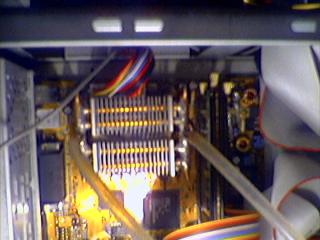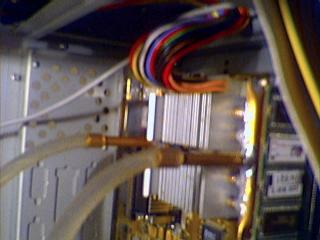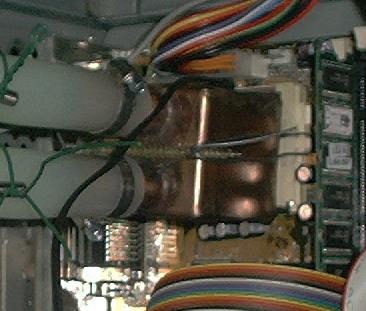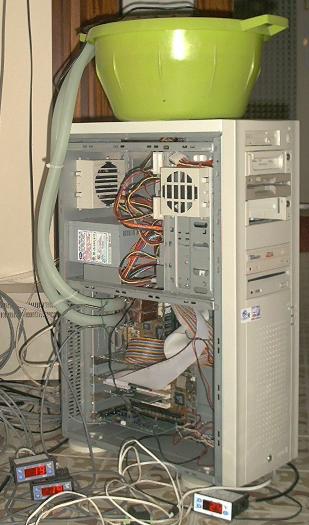Abstract
The possibility of cooling a CPU with gravitational convective flow of water is analyzed and experimented with positive results.
Many liquid cooling systems have been experimented by overclockers to better dissipate the heat from CPUs. The major part of these coolers is characterized by a relatively complex system requiring pumps or other active devices. Sometimes even liquid nitrogen is used.
My intent was instead to build a cooler able to dissipate the same heat flux of a normal heatsink, but without the annoying noise of the fan.
A first prototype was built out of a regular heatsink. Holes were drilled in the aluminium finning, and copper tubes passed through them. An aquarium pump provided the necessary pressure for circulation.
Figure 1. First Prototype—Front View

Figure 2. First Prototype—Side View

The system was silent and reliable. But with bigger pipes and a lower pressure drop would it have been possible to take away the pump? Simple calculations showed that it would have been perhaps feasible and a prototype was built.
Roughly:
Power to be dissipated: powd = 80 W
If the heatsink is a little copper box to put over the CPU, a reasonable value for the surface available at copper-water interface can be: surfc = 0.01 m2
The heat transfer coefficient on the water-copper boundary layer can vary from a few watt per square meter per kelvin if the flow is slow and laminar to more than 1 kW K-1m-2 when the flow is very fast and turbulent. If the coefficient is supposed to be: texc = 100 W K-1m -2
The difference of temperature on surface will be: delt = powd / (texc surfc) = 80 K
It's too much. It appears that the water should boil on the surface of such a little heatsink, but radiation wasn't taken into account and the geometry of the box is complex, so it's not clear if there could be turbulence and with which effect. If necessary the surface could be enhanced with fins or by increasing the dimension of the equipment.
Supposing that the heatsink could be able to exchange the heat between the CPU and the water, would it flow through the pipes?
Power to convey: powd = 80 W
Length of the circuit branches between the CPU and the radiator on the top of the computer case: heigh = 0.8 m
Equivalent length of the circuit (we take into account the bends too): len = 2 m
Radius of the pipe: rdp = 9 10-3 m
Rate of change of water density against temperature: dct = 0.55 kg m-3 K -1
Water density: rho = 103 kg m-3
Water viscosity: eta = 10-3 decapoise
Specific heat of water: wsh = 4180 J kg-1 K -1
Gravitational acceleration: grav = 9.8 m s-2
Pi: pi = 3.14
Difference of temperature between ascending and descending branch: deltat
Difference of density of the water in the two branches: deltarho = deltat dct
Difference of pressure due to the difference of density: deltap = deltarho grav heigh
Volume of water conveyed per unit time: vot
Pressure drop in the pipe (Poiseuille equation): deltap = vot 8 eta len / (pi rdp 4)
Power conveyed: powd = wsh rho deltat vot
Putting it all together: deltat2 = 8 powd eta len / (wsh rho pi rdp 4 dct grav heigh) = 3.4 K2
Everything should work with a temperature difference of less than 2 kelvin. Consequently the radiator isn't required to be very efficient.
The SIRPAL-1 prototype was made using a 5 mm thick copper sheet for the base, and 2 mm thick copper sheets for the walls. The edge of the square base is 55 mm long. Inside there are two plates 25 mm wide. One is vertically aligned, soldered to the base, to increase the exchange surface near the CPU, the other is horizontal, soldered between the input-output pipe fittings, to guide the fluid in the right direction.
A test was performed on a K6-2 450MHz which dissipates a power of about 25 watt. The ambient temperature was 18 celsius degrees. After a few hours the CPU temperature, measured by the PC board sensor, was at least 1 kelvin lower than when the fan is used. External surface temperatures: 19 celsius degrees on the pipes; 24 celsius degrees on the copper box.
A drop of ink in the water revealed a slow flow as expected. It worked so well that I think a more powerful CPU would be efficiently cooled too.
The bowl will be replaced by a proper radiator when available.
Figure 3. SIRPAL-1

Figure 4. SIRPAL-1—Testing
